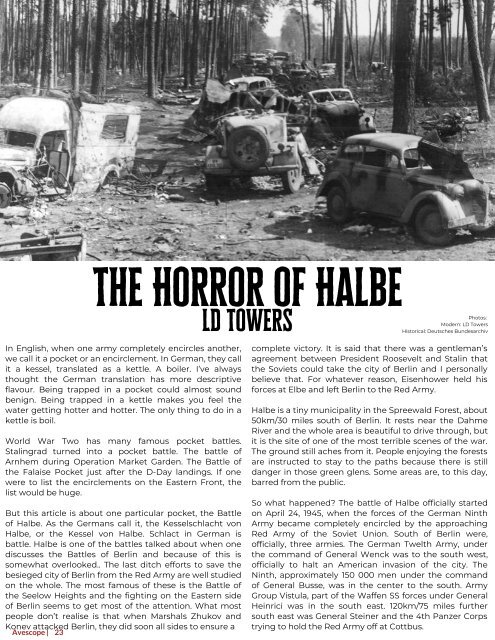Avescope HORROR
Avescope is back with our amazingly scary THIRD issue! With amazing fiction from Anike Kirsten and Guendolen Jacobs! Art from Joanna Hatton, (our brilliant cover is one of hers!) Justine Oh Me, Blackbird's Photography, and Catherine Jackson. Articles from Catherine Clark, David Simon, and Auguste von Osterode. LD Towers continues her serialized novel, Sal Adin! What can you read about? Of course, we covered Greta Thunberg. Governments and waste? Oh yes! The difficulty of saying 'No' when in a romantic encounter. A little military history with the Battle of Halbe.
Avescope is back with our amazingly scary THIRD issue! With amazing fiction from Anike Kirsten and Guendolen Jacobs! Art from Joanna Hatton, (our brilliant cover is one of hers!) Justine Oh Me, Blackbird's Photography, and Catherine Jackson. Articles from Catherine Clark, David Simon, and Auguste von Osterode. LD Towers continues her serialized novel, Sal Adin!
What can you read about? Of course, we covered Greta Thunberg. Governments and waste? Oh yes! The difficulty of saying 'No' when in a romantic encounter. A little military history with the Battle of Halbe.
You also want an ePaper? Increase the reach of your titles
YUMPU automatically turns print PDFs into web optimized ePapers that Google loves.
The Horror of Halbe<br />
Photos:<br />
Modern: LD Towers<br />
Historical: Deutsches Bundesarchiv<br />
In English, when one army completely encircles another,<br />
we call it a pocket or an encirclement. In German, they call<br />
it a kessel, translated as a kettle. A boiler. I’ve always<br />
thought the German translation has more descriptive<br />
flavour. Being trapped in a pocket could almost sound<br />
benign. Being trapped in a kettle makes you feel the<br />
water getting hotter and hotter. The only thing to do in a<br />
kettle is boil.<br />
World War Two has many famous pocket battles.<br />
Stalingrad turned into a pocket battle. The battle of<br />
Arnhem during Operation Market Garden. The Battle of<br />
the Falaise Pocket just after the D-Day landings. If one<br />
were to list the encirclements on the Eastern Front, the<br />
list would be huge.<br />
But this article is about one particular pocket, the Battle<br />
of Halbe. As the Germans call it, the Kesselschlacht von<br />
Halbe, or the Kessel von Halbe. Schlact in German is<br />
battle. Halbe is one of the battles talked about when one<br />
discusses the Battles of Berlin and because of this is<br />
somewhat overlooked.. The last ditch efforts to save the<br />
besieged city of Berlin from the Red Army are well studied<br />
on the whole. The most famous of these is the Battle of<br />
the Seelow Heights and the fighting on the Eastern side<br />
of Berlin seems to get most of the attention. What most<br />
people don’t realise is that when Marshals Zhukov and<br />
Konev attacked Berlin, they did soon all sides to ensure a<br />
<strong>Avescope</strong> | 23<br />
LD Towers<br />
complete victory. It is said that there was a gentleman’s<br />
agreement between President Roosevelt and Stalin that<br />
the Soviets could take the city of Berlin and I personally<br />
believe that. For whatever reason, Eisenhower held his<br />
forces at Elbe and left Berlin to the Red Army.<br />
Halbe is a tiny municipality in the Spreewald Forest, about<br />
50km/30 miles south of Berlin. It rests near the Dahme<br />
River and the whole area is beautiful to drive through, but<br />
it is the site of one of the most terrible scenes of the war.<br />
The ground still aches from it. People enjoying the forests<br />
are instructed to stay to the paths because there is still<br />
danger in those green glens. Some areas are, to this day,<br />
barred from the public.<br />
So what happened? The battle of Halbe officially started<br />
on April 24, 1945, when the forces of the German Ninth<br />
Army became completely encircled by the approaching<br />
Red Army of the Soviet Union. South of Berlin were,<br />
officially, three armies. The German Twelth Army, under<br />
the command of General Wenck was to the south west,<br />
officially to halt an American invasion of the city. The<br />
Ninth, approximately 150 000 men under the command<br />
of General Busse, was in the center to the south. Army<br />
Group Vistula, part of the Waffen SS forces under General<br />
Heinrici was in the south east. 120km/75 miles further<br />
south east was General Steiner and the 4th Panzer Corps<br />
trying to hold the Red Army off at Cottbus.





